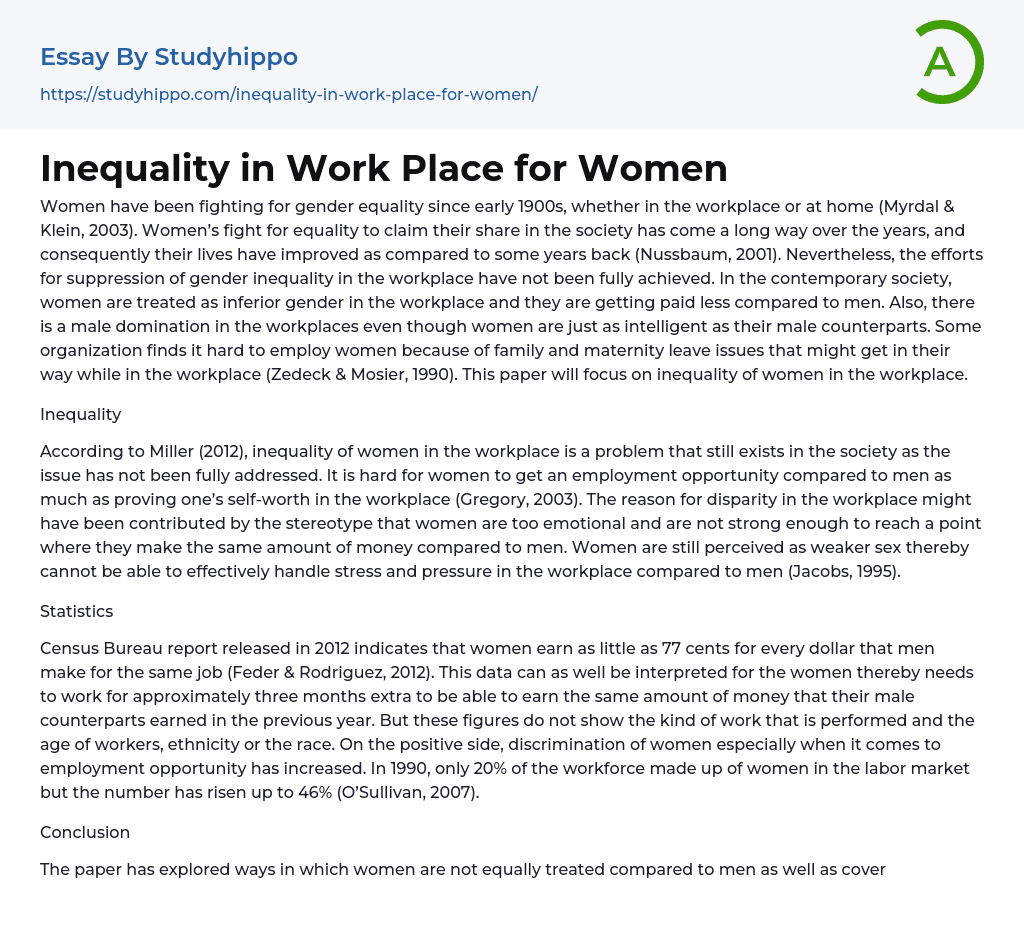Since the early 1900s, women have been advocating for gender equality in both the workplace and at home (Myrdal & Klein, 2003). Their continuous efforts have resulted in significant advancements that have improved the lives of women compared to previous times (Nussbaum, 2001). Nevertheless, completely eradicating gender inequality in the workplace continues to be a difficult task.
In today's society, women often experience discrimination and receive lower pay in the workplace compared to men. Despite having equal intelligence as their male counterparts, women frequently find themselves in predominantly male environments. Concerns about family and maternity leave can make some organizations hesitant to hire women (Zedeck ; Mosier, 1990). This paper aims to analyze the issue of inequality that women face in the workplace.
Inequality
According to Miller (2012), gender inequality persists in the workplace and ha
...s not been fully resolved.
According to Gregory (2003) and Jacobs (1995), women encounter challenges in finding employment opportunities and demonstrating their value in the workplace compared to men. These difficulties may arise from the stereotype that women are too emotional and not strong enough to receive equal pay as men, making it more difficult for them to effectively handle workplace stress and pressure.
Statistics
A 2012 report by the Census Bureau, cited by Feder ; Rodriguez (2012), reveals that women earn only 77 cents for every dollar men make in the same job. This data suggests that women must work approximately three extra months to earn what their male counterparts did in the previous year.
The provided statistics do not take into account the specific nature of the work or the characteristics of the workers, such as age, ethnicity, or race. However, discrimination against women i
terms of employment opportunities is on the rise. In 1990, only 20% of the workforce consisted of women, but that percentage has now increased to 46% (O’Sullivan, 2007).
Conclusion
This study focuses on the unequal treatment of women compared to men and presents statistical data regarding women in the workplace. It is crucial for all employees to have equal chances for job advancement and for recognition to be based solely on merit rather than gender. This will help foster unity and create a positive work environment for everyone involved (Beneria, Berik ; Floro, 2015).
Addressing the issue of inequality of women in the workplace promptly is crucial to achieving an organization's objectives and full productivity. Ensuring equal treatment of all employees in the workplace is essential for making them feel like a valued part of the organization (Cropanzana et al, 2007).
References
- Beneria, L., Berik, G., & Floro, M. (2015). Gender, development and globalization: economics as if all people mattered. Routledge.
- Cropanzana, R., Bowen, D. E., & Gilliland, S. W. (2007).
The article "The management of organizational justice" by The Academy of Management Perspectives (34-48) and the report "The State of Working Connecticut 2012: Employment, Jobs and Wages in the Wake of the Great Recession" by Feder, K., & Rodriguez, O. (2012) discuss different aspects of organizational justice. Additionally, Gregory, R.F. also contributes to the topic.
(2003). Women and workplace discrimination: Overcoming barriers to gender equality. New Brunswick, NJ u.a.: Rutgers Univ. Press.
Jacobs, J. A. (1995). Gender inequality at work.
Thousand Oaks u.a.: Sage Publ.
of women. Beacon Press.
Psychology Press.
Gender and the Workforce. Contemporary Ireland: A sociological map, 265-82.
- Gender Inequality In The Workplace essays
- Equality essays
- Gender equality essays
- Gender Inequality essays
- Minority essays
- Segregation essays
- Social Inequality essays
- Boy essays
- Gay essays
- Gender essays
- Gender Identity essays
- Gender Roles In Society essays
- Gender Stereotypes essays
- Girl essays
- Homosexuality essays
- Human Sexual Behavior essays
- Lgbt essays
- Man essays
- Masculinity essays
- Sexual Orientation essays
- Transgender essays
- Woman essays




